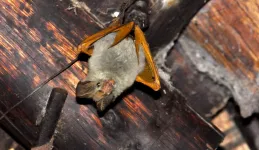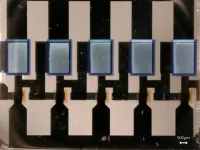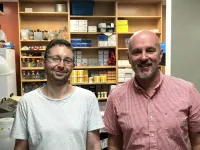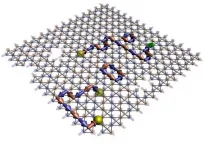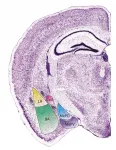First 3D simulation of rat's complete whisker system acts as a tactile 'camera'
Model gives rare insight into how rats use whiskers to actively sense their natural environments
2021-07-16
(Press-News.org) Northwestern University engineers have developed the first full, three-dimensional (3D), dynamic simulation of a rat's complete whisker system, offering rare, realistic insight into how rats obtain tactile information.
Called WHISKiT, the new model incorporates 60 individual whiskers, which are each anatomically, spatially and geometrically correct. The technology could help researchers predict how whiskers activate different sensory cells to influence which signals are sent to the brain as well as provide new insights into the mysterious nature of human touch.
The research was published last week in the Proceedings of the National Academy of Sciences.
With just a brush of their whiskers, rats can extract detailed information from their environments, including an object's distance, orientation, shape and texture. This keen ability makes the rat's sensory system ideal for studying the relationship between mechanics (the moving whisker) and sensory input (touch signals sent to the brain).
But while the rat whisker system is a widely used simplified model system in sensory neuroscience, it's challenging to study an animal's nervous system as it moves to interact with its natural environment.
"We cannot measure the signals at the base of a real rat's whisker using current technology because, as soon as you embed a sensor, it interferes with the signals themselves," said Northwestern's Mitra Hartmann, the study's senior author. "The only way we can really capture a rat actively sensing its environment under natural conditions is to simulate it."
With potential to overcome these challenges, simulations have become an increasingly important component of neuroscience. By developing WHISKiT, the study authors now have the first complete model of tactile input to a moving sensory system, which shows how rats actively "whisk" and passively sense their complex 3D environments.
"Because none of the individual whiskers works in isolation, WHISKiT is crucial to understanding how the brain processes incoming tactile sensory information," said Nadina Zweifel, the paper's first author. "It's equivalent to a tactile 'camera' that can capture the mechanical signals an animal may acquire while using the whiskers to interact with the environment. That way, we believe that our tool considerably widens the range of possibilities for computational and experimental studies in the future."
Hartmann is a professor of biomedical and mechanical engineering at Northwestern's McCormick School of Engineering, where she is a member of the Center for Robotics and Biosystems and the Northwestern University Interdepartmental Neuroscience program. Zweifel is a Ph.D. candidate in Hartmann's laboratory.
To develop the new WHISKiT model, the Northwestern team combined more than a decade's worth of experimental data from Hartmann's lab. Because every whisker is slightly different, her group previously calculated the proper geometry (including arc, base diameter and slope) for individual whiskers. After validating models for individual whiskers, the researchers combined the whiskers into a full array.
The resulting model considers the geometry, spatial arrangement and movement of all 60 whiskers (30 on each side) on a rat's face. Each whisker is embedded in a follicle, where the mechanical signals are generated at the base.
WHISKiT also incorporates new data collected from 3D scans that Zweifel captured of rats' natural environments, including in urban alleys, around dumpsters and at drain pipes, across the cities of Chicago and Evanston. The model simulates rats in these natural environments ("whisking" around a drain pipe, for example) as well as in laboratory settings. The researchers found that each typical, exploratory scenario generates a unique pattern of data.
"The tactile signals associated with exploring a complicated drain pipe or dumpster are very different from those associated with exploring a blank wall," Hartmann explained.
The researchers next plan to use the simulation to address several long-standing questions, including how rats can use touch to distinguish between stationary and moving objects and how active whisking compares to passive sensing.
INFORMATION:
The study, "A dynamical model for generating synthetic data to quantify active tactile sensing behavior in the rat," was authored by Hartmann, Zweifel, Nicholas Bush, Ian Abraham and Todd Murphey.
ELSE PRESS RELEASES FROM THIS DATE:
2021-07-16
Bat conversations might be light on substance, according to researchers from the University of Cincinnati.
Echoes from bats are so simple that a sound file of their calls can be compressed 90% without losing much information, according to a study published in the journal PLOS Computational Biology.
The study demonstrates how bats have evolved to rely on redundancy in their navigational "language" to help them stay oriented in their complex three-dimensional world.
"If you can make decisions with little information, everything becomes simpler. That's nice because you don't need a lot of complex neural machinery to process and store that information," study co-author Dieter Vanderelst ...
2021-07-16
Physicists of the Technische Universität Dresden introduce the first implementation of a complementary vertical organic transistor technology, which is able to operate at low voltage, with adjustable inverter properties, and a fall and rise time demonstrated in inverter and ring-oscillator circuits of less than 10 nanoseconds, respectively. With this new technology they are just a stone's throw away from the commercialization of efficient, flexible and printable electronics of the future. Their groundbreaking findings are published in the renowned journal "Nature Electronics".
Poor performance is still impeding the commercialization ...
2021-07-16
Researchers at Vanderbilt University Medical Center (VUMC) and the Baylor College of Medicine in Houston, Texas, have taken a big step toward developing targeted treatments and vaccines against a family of viruses that attacks the gastrointestinal tract.
Each year in the United States circulating strains of the human norovirus are responsible for approximately 20 million cases of acute gastroenteritis. Hallmark symptoms include severe abdominal cramping, diarrhea and vomiting.
Several vaccine candidates are in clinical trials, but it is unclear how effective they will be, given the periodic emergence of novel norovirus variants. Developing ...
2021-07-16
All cancers fall into just two categories, according to new research from scientists at Sinai Health, in findings that could provide a new strategy for treating the most aggressive and untreatable forms of the disease.
In new research out this month in Cancer Cell, scientists at the Lunenfeld-Tanenbaum Research Institute (LTRI), part of Sinai Health, divide all cancers into two groups, based on the presence or absence of a protein called the Yes-associated protein, or YAP.
Rod Bremner, senior scientist at the LTRI, said they have determined that all cancers ...
2021-07-16
WHAT:
A new study published in Nature Communications suggests that gene therapy delivered into the brain may be safe and effective in treating aromatic L-amino acid decarboxylase (AADC) deficiency. AADC deficiency is a rare neurological disorder that develops in infancy and leads to near absent levels of certain brain chemicals, serotonin and dopamine, that are critical for movement, behavior, and sleep. Children with the disorder have severe developmental, mood dysfunction including irritability, and motor disabilities including problems with talking ...
2021-07-16
LOS ALAMOS, N.M., July 15, 2021-- Using a D-Wave quantum-annealing computer as a testbed, scientists at Los Alamos National Laboratory have shown that it is possible to isolate so-called emergent magnetic monopoles, a class of quasiparticles, creating a new approach to developing "materials by design."
"We wanted to study emergent magnetic monopoles by exploiting the collective dynamics of qubits," said Cristiano Nisoli, a lead Los Alamos author of the study. "Magnetic monopoles, as elementary particles with only one magnetic pole, have been hypothesized by many, and famously by Dirac, but have proved elusive so far."
They realized an artificial spin ice by using the superconducting qubits of the quantum machine as a magnetic building block. Generating magnetic materials ...
2021-07-16
Great leaps in science and technology have been propelled by recent advances in seeing fast evolving physical phenomena, as they happen. Femtosecond lasers from the infrared to the X-ray region have enabled us to 'watch', in real time, atoms dance in molecules and solids on femtosecond and picosecond timescales. Watching such fascinating motions not just in real time but at the spatial locations where they happen, is a bigger challenge.
It is precisely this advance that has been made by a team of researchers at the Tata Institute of Fundamental Research, Mumbai, York University and the Rutherford Appleton Laboratories, UK [1]. They exploded a solid surface with an ultrahigh ...
2021-07-16
Fear is an important reaction that warns and protects us from danger. But when fear responses are out of control, this can lead to persistent fears and anxiety disorders. In Europe, about 15 percent of the population is affected by anxiety disorders. Existing therapies remain largely unspecific or are not generally effective, because the detailed neurobiological understanding of these disorders is lacking.
What was known so far is that distinct nerve cells interact together to regulate fear responses by promoting or suppressing them. Different circuits of nerve cells are involved in this process. A kind of "tug-of-war" takes place, with one brain circuit ...
2021-07-16
A new way of producing coherent light in the ultra-violet spectral region, which points the way to developing brilliant table-top x-ray sources, has been produced in research led at the University of Strathclyde.
The scientists have developed a type of ultra-short wavelength coherent light source that does not require laser action to produce coherence. Common electron-beam based light sources, known as fourth-generation light sources, are based on the free-electron laser (FEL), which uses an undulator to convert electron beam energy into X-rays.
Coherent light sources are powerful tools that enable research in many areas of medicine, biology, material sciences, chemistry and physics.
This new way of producing coherent radiation could revolutionise light sources, as it would ...
2021-07-16
In the field of industrial engineering, using simulations to model, predict and even optimise the response of a system or device is widespread, as it is less expensive and less complex -and, sometimes, less dangerous- than fabricating and testing several prototypes.
This type of simulation studies uses numerical methods that, depending on the problem to be addressed -for example, reducing the aerodynamic forces of an aircraft by changing its shape or using the minimum possible amount of material on elements under loading without breaking- require the simulation of a wide variety of possible combinational cases, which entails high computational costs.
The researchers from the School of Industrial Engineering of the University of Malaga Francisco Javier Granados Ortiz ...
LAST 30 PRESS RELEASES:
[Press-News.org] First 3D simulation of rat's complete whisker system acts as a tactile 'camera'
Model gives rare insight into how rats use whiskers to actively sense their natural environments
